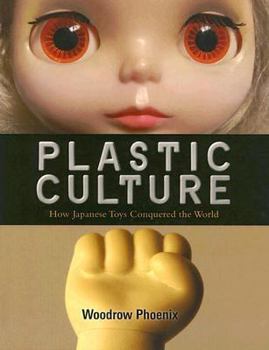Plastic Culture: How Japanese Toys Conquered the World
Plastic toys based on Japanese comics, movies and TV shows from Astro Boy , Godzilla and Gatchaman , to Power Rangers , Sailor Moon and Pokemon , have had a powerful effect on the imaginations and the... This description may be from another edition of this product.
Format:Hardcover
Language:English
ISBN:4770030177
ISBN13:9784770030177
Release Date:August 2006
Publisher:Kodansha
Length:109 Pages
Weight:1.32 lbs.
Dimensions:0.6" x 7.8" x 10.1"
Customer Reviews
3 ratings
Urban vinyl at its best!
Published by Thriftbooks.com User , 16 years ago
This is an amazing book! Eloquently written, with great insights into toys as a whole, this book gives a comprehensive overview of the emergence of designer vinyl. Great images!
now i feel much smarter This book is great
Published by Thriftbooks.com User , 17 years ago
All the cool pictures of toys I can't have are nice. But it's really better than all the other toy books becuase it explains all about toys and how come they are so cool. I know it was for adult level reader but I learned a lot that my friends don't know! It wasn't hard to read and I wish it was twice the size. My only problem is There was not enough Blythe information even though she's on the cover.
Urban Vinyl
Published by Thriftbooks.com User , 18 years ago
Ah, what a wonderful invention plastic is! Nearly limitless possibilities, able to be shaped into almost any form, take on any color, and endure across the centuries. As functional as it is fantastic. Of course, it was only a matter of time before artists took this malleable material into their capable hands, and created something that the inventors of the plastic would have never imagined. In this case, it is toys. "Plastic Culture: How Japanese Toys Conquered the World" supposes to tell the story of plastic, and its journey from function to fantastic, from commerce to art. Supposes to, because unfortunately the book seems to have fallen victim to a loss of focus, or possibly a conflict between writer and editor. Instead of this history of plastic, and their connection to Japanese culture, what the writer wanted to write about was an artistic movement called Urban Vinyl, originating in Hong Kong and then spreading to Japan and the US. That's his passion, and it shows. The first half of "Plastic Culture" is rough. It begins with a very brief history of plastic's invention, and its use in toys across the years. There is some brief connection with Japan, introducing the Kaiyodo model makers who perfected the garage kit. There is a half-hearted section on using toys for marketing purposes as mascots, mainly mentioning McDonalds Happy Meal toys and the Olympics. Trying to swing the story back to Japan, Sanrio is covered with their successful line of Hello Kitty figures and other characters. These articles are all short on text, and heavy on pictures, jumping rapidly from section to section without much logic or interest. Its pretty boring, and not very well researched. Then, on page 43, author Woodrow Pheonix begins the section on Urban Vinyl. And it all changes. The Urban Vinyl movement began in Hong Kong, with a couple of young talents started taking apart GI Joe figures and putting them back together street-style, dressed in the latest Hong Kong fashions and with an attitude that GI Joe never imagined. These two, Michael Lau and Eric So, exhibited their work at galleries, and inspired other artists to see toys as a medium of expression, rather than just playthings. The movement jumped across the water, to Japan with its ingrained toy culture, and then to the US underground comics scene, where artists like Dan Clowes ("Ghost World") and Archer Prewitt ("Sof' Boy") began teaming up with Asian designers to produce unique figures combining all of their talents and visions. Into this comes Takashi Murakami, famed for his Superflat exhibition and one of Japan's greatest modern artists, who sees the concept of creating original works of art in toys, rather than just reproducing existing works in plastic. Yoshitomo Nara, another prominent Japanese modern artist, follows suit. Its fascinating. If this book had been called "Urban Vinyl," and started with Lau and So in Hong Kong, then been given enough depth to explore the art






